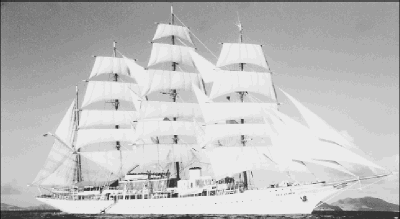 Within a few short years, SOLAS prohibitions
against wood on commercial ships will end her life as a yacht that carries paying
passengers, but the 360-foot Sea Cloud has already had nine lives and smart money is
betting that there will be many more. For now, she's cruising the Caribbean in winter and
the Mediterranean in summer as frisky as a kid, not at all like the 68-year-old dowager
she is.
Within a few short years, SOLAS prohibitions
against wood on commercial ships will end her life as a yacht that carries paying
passengers, but the 360-foot Sea Cloud has already had nine lives and smart money is
betting that there will be many more. For now, she's cruising the Caribbean in winter and
the Mediterranean in summer as frisky as a kid, not at all like the 68-year-old dowager
she is. Her hull is stalwart, German steel that ended up serving in the U.S. Navy against German U-boats that couldn't (or wouldn't) sink her. After the war, however, she was returned to the mellow, mahogany magnificence that reigns still today. Great expanses of glowing woods line her library, dining room, and 34 staterooms. Teak floors her decks. Brightwork on her miles of rails keeps much of the credit.
The story begins in Battle Creek, Michigan, where C.W. Post founded a cereal empire rivaled only by Kellogg's. His daughter Marjorie learned the family business at her father's side and, when he died a suicide at age 60, she stepped into his shoes. Married to an eastern aristocrat and never quite accepted by what passed for Society in the east, Marjorie Merriwether Post nevertheless made her mark. w of 60 busy with sandpaper and varnish all year.mother's, has a fireplace, walk-in closet, and a marble bath. Owners' cabins 1 and 2 are still the most desired, and have to be booked a year or more in advance.
Marjorie died in the 1970s and most of her mansions are gone or in new hands. Her priceless art works are in museums. Her jewels are scattered. But Sea Cloud continues to dance around the globe in the grand manner she was meant for when she was launched, after almost five years a-building, in 1931. The yacht cost a cool $1 million in a day when a good crewman could be hired for $75 a month and found (an archaic term that means the employer will "find" the worker's food, lodging, uniforms, and other needs.) No design feature was too grand. She had a diesel electric system and watertight doors of a type that, at the time, were found only on submarines. There was grumbling at home about the job going to a German shipyard when American shipbuilders were in a depression, but Hutton was a sailor. The Germans were still building square riggers in the 1930s, and they knew their stuff.
On arrival in New York, the yacht cost her owner an additional $95,000 in duty. One refit alone cost more than $3 million and required eight miles of manilla rope, acres of sailcloth, hogsheads of varnish, and millions of man-hours of loving labor.
All this history, this luxury and legend, this maritime magic, is accessible today to lucky travelers. Our own cruise began and ended in Antigua, but that is just part of the story. Enchantment follows Sea Cloud wherever she goes. She turns heads today just as she did in the 1930s when Marjorie and her then-husband Joe Davies, President Franklin Roosevelt's ambassador to the Soviet Union, brought her up the Neva River to Leningrad so the Davies's wouldn't have to live in the seedy, poorly heated, and thoroughly bugged American embassy.
In her belly, Sea Cloud carried a secret social weapon. In the late 1920s, Marjorie had met Clarence Birdseye, who was experimenting with a new food preservation process.